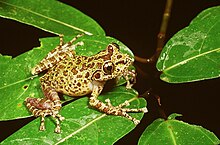Spinomantis
| Spinomantis | ||||||||||||
|---|---|---|---|---|---|---|---|---|---|---|---|---|

|
||||||||||||
| Systematics | ||||||||||||
|
||||||||||||
| Scientific name | ||||||||||||
| Spinomantis | ||||||||||||
| Dubois , 1992 |

Spinomantis is a genus of frogs from the Madagascar frog family.
features
The species are rather small to medium-sized and reach a head-trunk length of 22 to 60 millimeters. The representatives of the genus Spinomantis are usually not colored conspicuously, but rather wear camouflage colors . Various lobed and fringed skin appendages could also serve as camouflage on the bark of the trees along the rivers, which is overgrown with moss and lichen. The males do not have rutting callosities, but have femoral glands on the underside of the rear thighs. The webbed feet between the toes are rudimentary to moderately pronounced, they are not developed between the fingers. The fingertips are noticeably enlarged. The males have an unpaired throat pouch , in Spinomantis bertini and Spinomantis guibei it is paired or at least divided into two. The tongue is forked. The tympanum is the same in both sexes.
distribution
The species of the genus Spinomantis are endemic to eastern Madagascar .
Way of life
Many species are tree-dwelling and have various adaptations to this way of life, such as the widened fingertips and toes, which are used for climbing, and the coloring or corresponding skin flaps and fringes for camouflage on bark and branches. These species include, for example, S. aglavei , S. fimbriatus , S. massi , S. nussbaumi , S. peraccae , S. phantasticus and S. tavaratra . S. elegans , S. guibei S. microtis , S. bertini , S. beckei , S. mirus and S. brunae belong to the group of species that predominantly inhabit the soil . The species are predominantly nocturnal .
development
The eggs of the tree-dwelling species are yellowish. They are deposited on leaves that protrude over the water. The hatching tadpoles fall into the water, where further development takes place. The laying of eggs in the ground-dwelling species is largely unknown. They stay along slowly flowing water, where the tadpoles can also easily get into the water. The tadpoles of Spinomantis elegans , which have been studied in detail, are free-swimming.
Systematics and taxonomy
The genus Spinomantis was first described by the herpetologist Dubois in 1992 as a subgenus of Mantidactylus . Spinomantis aglavei , then still known as Rhacophorus aglavei , became the type species of the genus.
External system
For a long time the species of this genus were in different species groups and genera. This was due to the fact that, due to their very different habitats in Madagascar, they were not viewed as a single group. Only through phylogenetic studies was it possible to recognize the relationships within the genus. By Blommers locks they were partially combined into a sub-genus of Mantidactylus , which was then raised to a separate genus by Vences and Glaw. At the same time, the subfamily Mantellinae was established by Vences and Glaw , in which further groups of species or subgenus of Mantidactylus were placed as new genera, including Blommersia , Boehmantis , Gephyromantis , Guibemantis and Wakea .
species
The genus Spinomantis comprises a total of 14 species. In contrast to many other genera of Malagasy frogs, the number of newly described species in this genus is growing only slowly. In the years 2017 and 2019 were two new cryptic species complex by molecular biology isolated methods of an outwardly very similar type.
As of August 23, 2019
- Spinomantis aglavei (Methuen and Hewitt, 1913)
- Spinomantis beckei Vences, Köhler & Glaw, 2017
- Spinomantis bertini (Guibé, 1947)
- Spinomantis brunae (Andreone, Glaw, Vences & Vallan, 1998)
- Spinomantis elegans (Guibé, 1974)
- Spinomantis fimbriatus (Glaw and Vences, 1994)
- Spinomantis guibei (Blommers-Schlösser, 1991)
- Spinomantis massi (Glaw and Vences, 1994)
- Spinomantis microtis (Guibé, 1974)
- Spinomantis mirus Sabino-Pinto, Rakotoarison, Bletz, Edmonds, Glaw & Vences, 2019
- Spinomantis nussbaumi Cramer, Rabibisoa, and Raxworthy, 2008
- Spinomantis peraccae (Boulenger, 1896)
- Spinomantis phantasticus (Glaw & Vences, 1997)
- Spinomantis tavaratra Cramer, Rabibisoa & Raxworthy, 2008
Individual evidence
- ↑ a b c d Frank Glaw & Miguel Vences: Phylogeny and genus-level classification of mantellid frogs (Amphibia, Anura). Organisms, Diversity & Evolution, 6, pp. 236-253, 2006, doi : 10.1016 / j.ode.2005.12.001 .
- ↑ a b c Miguel Vences, Jörn Köhler & Frank Glaw: A new species of smooth-skinned Spinomantis frog (Anura: Mantellidae) from south-eastern Madagascar. Zootaxa, 4317, 2, pp. 133-142, 2017, doi : 10.11646 / zootaxa.4317.2.12 .
- ↑ M. Thomas, L. Raharivololoniaina, Frank Glaw, DR Vieites & Miguel Vences: Montane tadpoles in Madagascar: molecular identification and description of the larval stages of Mantidactylus elegans, M. madecassus and Boophis laurenti from the Andringitra Massif. Copeia 2005, pp. 174-183, 2005.
- ^ Alain Dubois: Notes on the classification of Ranidae (Amphibiens anoures). Bulletin Mensuel de la Société Linnéenne de Lyon, 61, pp. 305-352, 1992.
- ↑ RMA Blommers-Schlösser: Biosystematics of the Malagasy frogs I. Mantellinae (Ranidae). Beaufortia, 29, 1-77, 1979
- ↑ Darrel R. Frost: Spinomantis Dubois, 1992 , Amphibian Species of the World: an Online Reference, Version 6.0, American Museum of Natural History, 1998-2019, accessed August 23, 2019
- ↑ a b J. Sabino-Pinto, A. Rakotoarison, M. Bletz, D. Edmonds, Frank Glaw & Miguel Vences: A new species of the Spinomantis bertini species complex (Anura: Mantellidae) from Pic d'Ivohibe Special Reserve (Madagascar ) . Zootaxa, 4656, pp. 379-390, 2019.
literature
- Alain Dubois: Notes on the classification of Ranidae (Amphibians anoures). Bulletin Mensuel de la Société Linnéenne de Lyon, 61, pp. 305-352, 1992.
Web links
- Darrel R. Frost: Spinomantis Dubois, 1992 , Amphibian Species of the World: an Online Reference, Version 6.0, American Museum of Natural History, 1998-2019, accessed August 23, 2019


